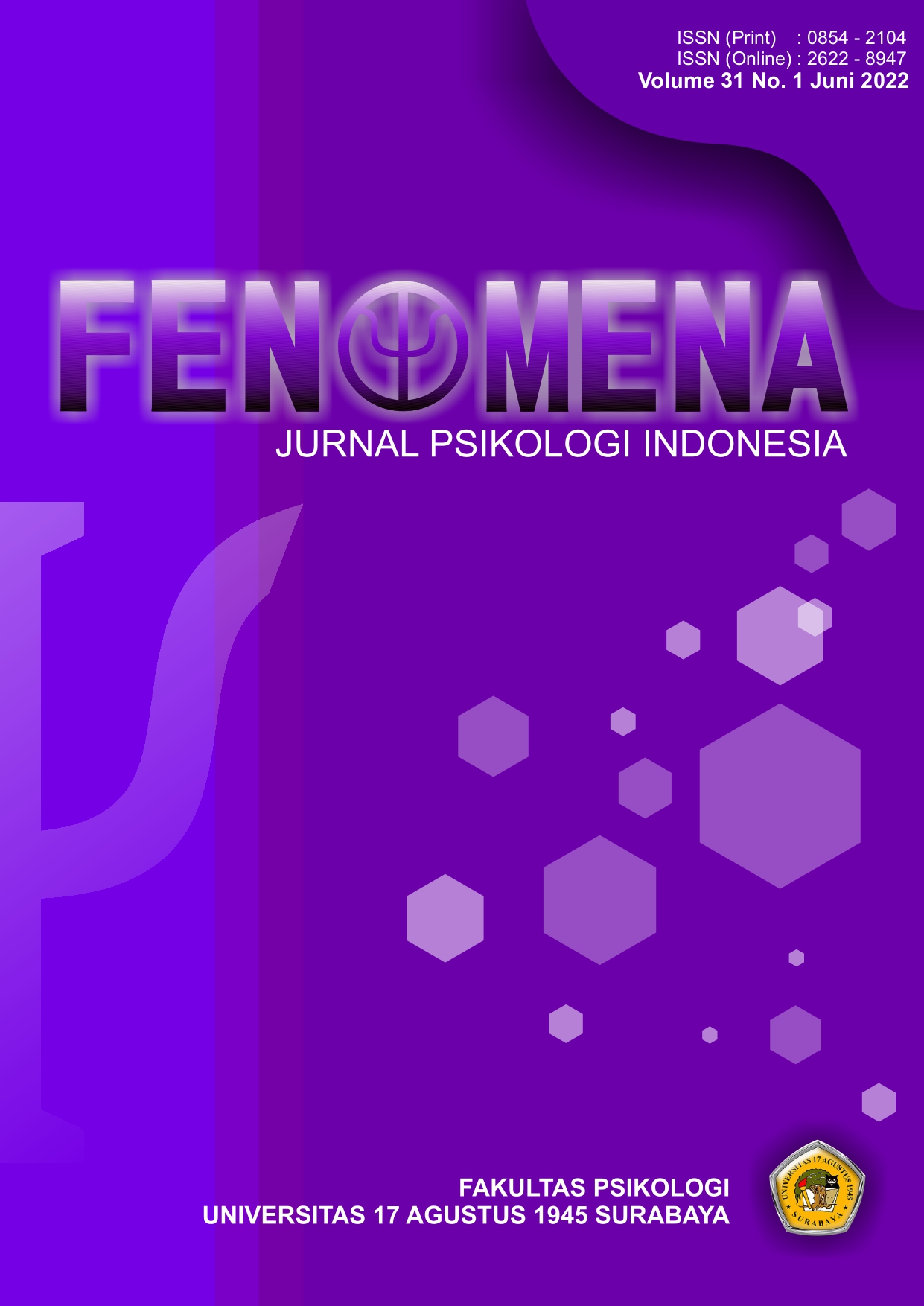Pengaruh Job Reattachment Dan Leader Safety Commitment Terhadap Work Adjustment Pada Karyawan di Masa Pandemi Covid-19
DOI:
https://doi.org/10.30996/fn.v31i1.6055Keywords:
Job reattachment, Leader safety commitment, Work adjustmentAbstract
Pada awal terjadinya masa pandemi Covid-19, banyak peraturan-peraturan yang ditetapkan oleh pemerintah dalam mengatasi keadaan tersebut. Salah satu contohnya adalah menetapkan peraturan bekerja dari rumah bagi karyawan di Indonesia. Namun saat keadaan mulai mereda, pemerintah memperbolehkan karyawan untuk kembali bekerja di kantor namun dengan syarat menaati protokol kesehatan sesuai anjuran dari pemerintah. Keterikatan kembali bekerja yang dialami karyawan yang sebelumnya bekerja dari rumah dan kembai mulai bekerja dari kantor menjadi suatu tantangan, karena karyawan diharuskan menyesuaikan diri kembali di tempatnya bekerja, seperti salah satu contohnya memakai masker saat bekerja. Adanya peraturan baru tersebut tidak lepas dari komitmen keselamatan pemimpin yang perlu diberlakukan juga guna membuat karyawannya merasa aman dalam pekerjaannya di kantor. Subjek penelitian ini merupakan karyawan yang sebelumnya melakukan Work From Home menjadi Work From Office. Metode yang digunakan dalam penelitian ini adalah metode penelitian kuantitatif. Subjek dari penelitian ini berjumlah 108 karyawan yang bekerja secara work from office selama masa pandemi dari berbagai kota di Indonesia. Alat ukur yang digunakan adalah Job reattachment Scale yang disusun oleh Sonnentag dan Kühnel (2016), Leader safety commitment Scale yang disusun oleh Beus (2019), dan Work adjustment Scale yang disusun oleh Shtivelband (2014). Analisis data yang dilakukan adalah analisis regresi linear berganda dan uji parsial dengan menggunakan program statistik IBM SPSS Statistic 22 for Windows. Hasil penelitian menunjukkan bahwa Job reattachment dan leader safety commitment secara bersama-sama berpengaruh terhadap work adjustment pada karyawan di masa pandemi Covid-19 ini.
Downloads
References
Ariadhy, Shulby Yozar, Sabar Nurohman, Darol Arkum, and Widya Handini. 2020. “Pelatihan Pembelajaran Jarak Jauh Di Era Pandemi Covid-19.” Jurnal ANOA.
Burns, Richard. 2016. “Psychosocial Well-Being.” In Encyclopedia of Geropsychology, 1–8. Singapore: Springer Singapore. https://doi.org/10.1007/978-981-287-080-3_251-1.
Chao, Miao, Xueming Chen, Tour Liu, Haibo Yang, and Brian J. Hall. 2020. “Psychological Distress and State Boredom during the COVID-19 Outbreak in China: The Role of Meaning in Life and Media Use.” European Journal of Psychotraumatology 11 (1): 1769379. https://doi.org/10.1080/20008198.2020.1769379.
Chaturvedi, Kunal, Dinesh Kumar Vishwakarma, and Nidhi Singh. 2021. “COVID-19 and Its Impact on Education, Social Life and Mental Health of Students: A Survey.” Children and Youth Services Review 121 (February): 105866. https://doi.org/10.1016/j.childyouth.2020.105866.
Chen, Fangping, Dan Zheng, Jing Liu, Yi Gong, Zhizhong Guan, and Didong Lou. 2020. “Depression and Anxiety among Adolescents during COVID-19: A Cross-Sectional Study.” Brain, Behavior, and Immunity 88 (August): 36–38. https://doi.org/10.1016/j.bbi.2020.05.061.
Courtney, Darren, Priya Watson, Marco Battaglia, Benoit H Mulsant, and Peter Szatmari. 2020. “COVID-19 Impacts on Child and Youth Anxiety and Depression : Challenges and Opportunities.” https://doi.org/10.1177/0706743720935646.
Hasking, Penelope, Stephen P. Lewis, Elana Bloom, Amy Brausch, Michael Kaess, and Kealagh Robinson. 2021. “Impact of the COVID-19 Pandemic on Students at Elevated Risk of Self-Injury: The Importance of Virtual and Online Resources.” School Psychology International 42 (1): 57–78. https://doi.org/10.1177/0143034320974414.
Hutauruk, Agusmanto, and Ropinus Sidabutar. 2020. “Kendala Pembelajaran Daring Selama Masa Pandemi Di Kalangan Mahapeserta didik Pendidikan Matematika: Kajian Kualiatatif Deskriptif.” Journal of Mathematics Education and Applied 02 (01): 45–51.
Kapur, Nav, Caroline Clements, Louis Appleby, Keith Hawton, Sarah Steeg, Keith Waters, and Roger Webb. 2021. “Effects of the COVID-19 Pandemic on Self-Harm.” The Lancet Psychiatry 8 (2): e4. https://doi.org/10.1016/S2215-0366(20)30528-9.
Kemdikbud. 2020. Kepmendikbud Nomor 719/P/2020 Tentang Pedoman Pelaksanaan Kurikulum Pada Satuan Pendidikan Dalam Kondisi Khusus. https://www.kemdikbud.go.id/main/blog/2020/08/kemendikbud-terbitkan-kurikulum-darurat-pada-satuan-pendidikan-dalam-kondisi-khusus.
Kemenkes. 2020. “Permenkes RI KMK No. HK.01.07/MENKES/382/2020.” Peraturan Menteri Kesehatan Republik Indonesia Nomor 9 (Pedoman Pembatasan Sosial Berskala Besar dalam Rangka Percepatan Penanganan Corona Virus DIsease 2019 (COVID-19)): 2–6. http://jurnalrespirologi.org/index.php/jri/article/view/101.
Downloads
Published
Issue
Section
License
Authors retain copyright and grant the journal right of first publication with the work simultaneously licensed under a Creative Commons Attribution 4.0 International License that allows others to share the work with an acknowledgment of the work's authorship and initial publication in this journal.






